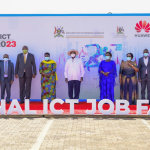DRC Sets To Join Standard Gauge Railway Project

The Democratic Republic of the Congo (DRC) has committed to participating in the ambitious Standard Gauge Railway (SGR) project in East Africa, aiming to link the Indian and Atlantic Oceans for enhanced regional connectivity and trade. Uganda invited the DRC to a meeting on this during the recent joint commission meetings. DRC will nominate engineers and coordinate with Uganda for SGR standards, with joint site visits planned by March 2024.

The Democratic Republic of the Congo (DRC) has pledged its participation in the ambitious Standard Gauge Railway (SGR) project in East Africa.
By linking the Indian and Atlantic Oceans, the trans-African railway line project hopes to enhance regional connectivity and trade.
It was decided that Uganda will invite DRC to the following meeting of the Northern Corridor Infrastructure Projects of SGR Cluster during the DRC-Uganda Joint Permanent Commission (JPC) meetings that took place this past weekend in Kinshasa.
The meeting decided that DRC would “nominate three Engineers to represent the country in the SGR Cluster meetings by 30th December 2023.”
To facilitate the harmonisation of railroad standards with Uganda by March2024, the DRC will also discuss with Uganda the implementation schedule for the SGR network.
By March 2024, technical teams from both nations will also conduct joint site visits at the border crossing places.
During the SGR cluster meeting in Kampala, Uganda, in May 2023, the decision was made to encourage the DRC to participate in the railway project.
After specialists discovered that the SGR lines proposed by Kenya, Uganda, and Kenya ended at the borders of the DRC, this was done.
The SGR line in Uganda will travel from Malaba through Kampala, Bihanga, and Kasese to Mpondwe at the border with the DRC.

Phase 2 of Tanzania’s project, which will see the country build 506 km of the railway line from Tabora to Kigoma, connecting to Lake Tanganyika, has already seen the completion of feasibility studies and preliminary designs.
Despite having abundant resources of copper, cobalt, and gold as well as the second-largest rainforest in the world, the Democratic Republic of the Congo’s people continue to live in relative poverty as a result of inadequate transportation infrastructure and limited access to regional markets.
According to experts, the DRC’s involvement in the early stages of the SGR’s implementation will strengthen cooperation in the creation of the project’s feasibility studies and boost efforts to find funds.
The coordinator of the SGR Project, Eng. Canon Perez Wamburu, stated in an interview with ChimpReports in May 2023 that the DRC is a member of the EAC community and that various railway lines end up on the DRC border.
We would like to see the DRC participate in these programmes so that they can raise awareness of the project there as well, he continued.
We believe the DRC, a significant partner in our area, will be interested in the railway project to potentially expand the line further into their nation.
The Kinshasa rulings are viewed as a significant step towards improving trade ties between East and West African nations, primarily by cutting the amount of time that products must travel both within and outside of the continent.
Right today, 15% of all trade in Africa is conducted within the continent.
The Coordinator of the Northern Corridor Infrastructure Projects at Uganda’s Ministry of Foreign Affairs, Amb Richard Kabonero said investing in infrastructure links within the region is critical to unlocking our region’s economic potential.
According to Kabonero, by giving priority to the construction of roads, trains, canals, aviation, and ICTs, we can lower business costs, boost commerce, and promote economic growth.
Let’s cooperate to revive the NCIPs framework, build thorough plans for infrastructure growth, and get the funding required to make them a reality, he continued.
The DRC, which has a population of 95 million and is the fourth-largest in Africa, was accepted to the EAC in 2022.
Uganda exports mostly cement, palm oil, beer, sugar, iron and steel, rice, iron and steel (scrap), cocoa beans, and natural rubber. The DRC is one of Uganda’s largest commercial partners in East Africa.
For instance, in 2017, Uganda exported commodities to the DRC worth $188.98 million (Shs685 billion), whereas the DRC imported items worth $156.5 million (Shs567 billion) into Uganda. The exports from Uganda to the DRC increased dramatically, reaching $338.56 million (Sh1.2 trillion) in 2021.







